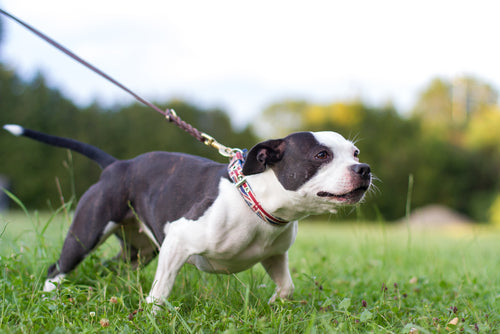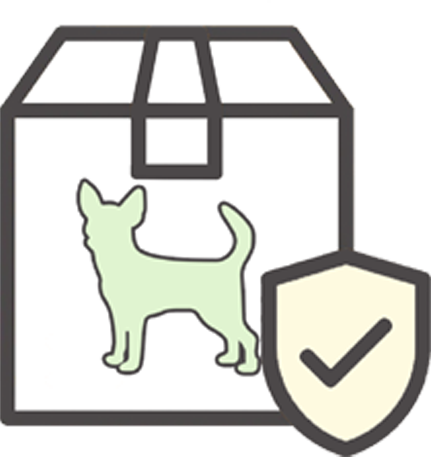What To Do When Your Dog Pulls On The Leash
Wednesday, May 31, 2017 11:12:09 AM America/Los_Angeles
 Source: annamarias, Shutterstock
Source: annamarias, Shutterstock
Whether you're a morning walker or you fit walks in after work, a nice leisurely stroll with your furry little friend can be both relaxing and peaceful. However, all of that can fall by the wayside if your dog starts pulling on their leash. Dogs naturally want to explore, smell, and take in their surroundings. It's exciting for them to be out of the house and to spend time with you, so pulling you along with them is only natural. The problem with allowing your dog to pull on their leash is that it establishes undesirable behavior outside, which can then be brought back inside. Here are a few tips and tricks to stop your dog pulling on the lead.
A Word of Caution Before Starting
It's important that you still take your dog out for normal walks even if their constant pulling is frustrating to you. Going for a walk outside is not just about letting your dog relieve themselves (you can have an indoor dog potty like DoggieLawn in your home for that--dogs need to urinate multiple times a day and can develop UTIs or other complications if they're not able to relieve themselves in a timely manner). Walking promotes mental stimulation and gives your dog a chance to bond with you and socialize with other humans and dogs.
It's human instinct to move on to the next training method if instant results are not obtained. While it's true different dogs learn in different ways, if you stop one training method as soon as you start it, your pup will become confused and not know what to do. You've probably learned or witnessed this when you were potty training. Stick with one training method, offer positive reinforcement, and remember to focus on yourself just as much as your dog, as your own body language can affect how your pet reacts. By keeping all of this in mind before you start leash training, you'll already be well on your way.
The Right Leash and Collar
Pick out the right leash and collar for your dog. Do you have a big powerful dog that is difficult to control once they get going? Consider a chest harness. This helps distribute weight around the shoulders and back, giving you more leverage to control your dog. There's nothing wrong with the old fashion collar, as long as you can control your dog and they don't control you.
If you grew up with dogs, there's a good chance your parents might have used a choke collar. While this has proven successful in the past, it also can cause problems with both your dog's walking abilities and their health. When an animal is cornered and trapped in the wild, it's their instinct to do what they can to get away. On a walk, if your dog pulls and the choke collar restricts their air flow, it's only natural for them to try and pull harder to get out of it. For some, it may eventually work as a dog learns that not pulling leads to being able to breathe easily. However, other methods for training your dog are kinder, faster, and healthier so avoid choke collars whenever possible.
Don't Let Them Reward Themselves
Dogs often pull when they're excited. Sometimes they're excited just to be outside and will pull no matter what. Other times, your dog might pull in order to smell a spot of grass on the other side of the street or they may want to investigate a squirrel hiding under the bushes up ahead. If your dog begins to pull, don't reward them and allow them to go where they want. If your dog learns they can pull you wherever they want, it teaches them that pulling works. While you want your dog to be happy, demonstrate that you are in control of the walk. When your dog discovers they're not able to go as they please, your dog's pulling will become less severe.
Stop and Start
If you're someone who likes to walk as fast as you can in order to complete the walk quicker, you'll need to train yourself just as much as your dog. Your dog will sense you're in a hurry and will likewise increase their pace. Consider taking a walk on your own if you want to fit in more outdoor time, at least until your dog is ready to go on longer walks without pulling. With the stop and start tip, allow your dog to walk by your side, and once they begin to pull, stop the walk completely. Wait for the leash to go slack before starting back up. Eventually your dog will learn that the only way the walk continue is if there isn't tension in the leash.
One tactic to consider while using stop and start is to reward your pup with a little treat when they walk beside you. You can give them more of these treats towards the beginning of training, but slowly reduce the frequency. If you don't, they'll begin to pester you for more treats during the walk, which leaves you with an entirely different problem. So once your dog is used to walking by your side for a treat, don't give the treat for simply walking next to you. Give them a treat when they don't bark or run towards another dog or they let a rabbit cross the street without lunging. It's all about positive reinforcement--your dog will learn faster through positive reinforcement over negative reinforcement.
Switch It Up
Taking the same route is easy. You know the distance, the people who will most likely be out, and how long it takes. Your dog also becomes accustomed to the sights and smells. Over time, if you were to let them off their leash they probably could lead the way back home. It's fine to take the same route when first training, but as your dog begins to stop pulling it's important for you to switch it up.
Without switching up your usual route, you won't be able to know if your dog has actually become a better walker or if they're simply just used to the path and has no reason to pull. Should you walk the same path day after day, they'll become accustomed to walking the path without listening to you, which causes problems should you need to take them out to a less familiar environment. Once you introduce them to a new environment, they could very well revert back to their former leash pulling self.
It's important to keep it interesting. Not only does your dog like to see new areas and smell different grass patches, but it also helps maintain their training. In keeping your pup on their toes, they'll need to learn to always expect the unexpected and to listen to you for your instructions at all times. Switching it up keeps your dog continuously learning and focused.
Short Training
A convenient way to train your dog is utilizing the sidewalk in front of your house. Place a dog treat further down the sidewalk but close enough for your dog to eventually see or smell the treat. When their senses take note of the treat, they'll begin to pull. As soon as they begin doing this, stop and return to the starting line. Repeat the process. Eventually, your dog will catch on that the pulling is what's preventing them from going after their treat. It might take practice, but your dog will catch on and the pulling will become a non factor.
Walking your dog is a loving activity. Your pet loves spending time outside with you and wants to enjoy it with you. However, far too many people simply put their dogs on the leash and go, paying little to no mind of their dog until they have to pick up after them. Make sure to talk to your dog. Tell them they do a good job. If they look back at you, say something to them and let them know you are proud of them. Dogs are some of the most affectionate animals on the planet and most of what they do, they do for you. So let them know that you're on the walk together and not just there there by happenstance. Even if you have headphones on, make it an oppourtunity to bond with your dog by maintaining communication.
If you live in a big city and your dog doesn't have their own yard to run around in, you should:
1. Give them their own backyard in a box such as DoggieLawn. This way they can go potty when you're not home (if you have a friend who could benefit from a grass patch for dogs, send them THIS LINK for a big discount on their first lawn) and you can focus on spending quality time with your furry friend when you are on a walk.
2. Continue taking them out to train them to be on a leash without pulling. Your dog will likely show excitement and try to pull while on the leash, but as long as you know how to handle this and how to train them, you'll be able to respond appropriately and have more enjoyable walks. So take advantage of these training tips. You and your pup will enjoy the walk that much more.

